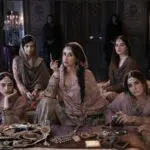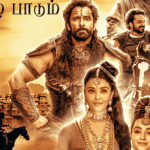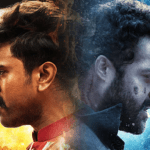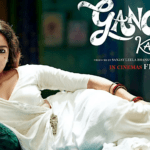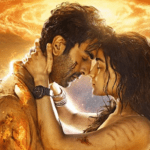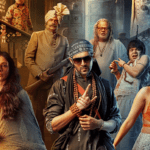Table of Contents
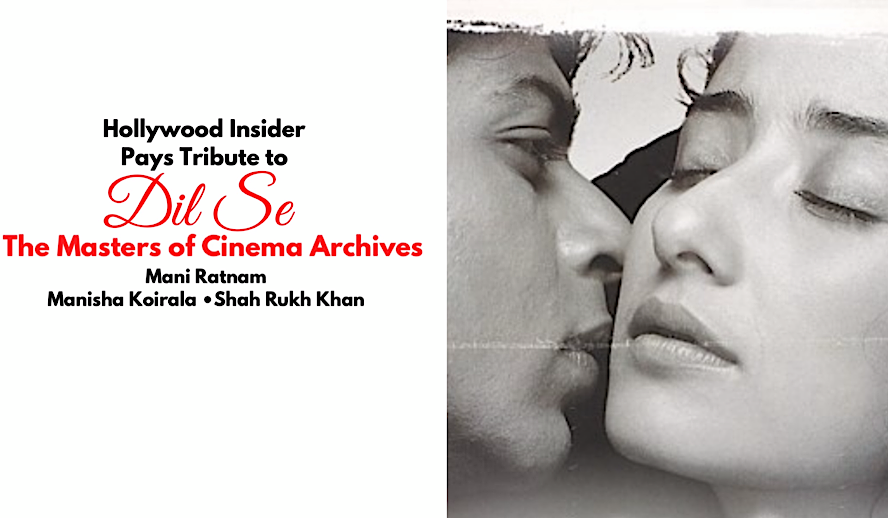
Video Version of this Article
Photo: Mani Ratnam’s ‘Dil Se’ with Shah Rukh Khan and Manisha Koirala/Eros International
With the utmost respect, Hollywood Insider would like to announce that we are paying tribute to Mani Ratnam’s masterpiece ‘Dil Se’ with its inclusion in The Masters of Cinema Awards. The awards recognize the greatest cinematic masterpieces chosen by a team of curators led by Pritan Ambroase, the CEO and editor-in-chief of Hollywood Insider. The Masters of Cinema Awards shines a light on films that prove the power of Cinema to elevate and transmute us. Additionally, this film is also included in Hollywood Insider’s Hidden Gems Series with which we aim to bring forth and highlight great international film directors and their Cinema must be watched from across the one-inch barrier of subtitles.
What makes a film a masterpiece is ambiguous. Is it the script that cements a movie as a classic? Is it a director’s vision that captures something previously unseen? Could it be an actor’s transformation that blurs the line of fiction? It’s not specifically clear what it is that elevates a film playing on a screen to a timeless hallmark of culture, but you know it when you see it. A masterpiece is found in a story that follows you home from the theater, plays over and over in your head before bed, and changes the way you think about your life. There are films and movies, then there is Cinema. Dil Se is Cinema.
Related article: Hollywood Insider’s CEO Pritan Ambroase: “The Importance of Venice Film Festival as the Protector of Cinema” – Cinema Will Survive and Thrive
Related article: The Masters of Cinema Awards: Hollywood Insider Pays Tribute to ‘La Vie En Rose’, Exclusive Interview with Director Olivier Dahan
A Masterpiece – A Saga – A Tale – True Poetry
Mani Ratnam struck that elusive magic in his 1998 classic-turned-masterpiece, Dil Se, an epic and tragically romantic saga essayed with the backdrop of a war raging on interspersing with their story as the lovers unite, collide, and eventually become one. Their love for each other reigning above their individual histories, erasing their individual futures, and tying their destiny into one. Dil Se, (meaning From the Heart), is an Indian romantic thriller, written and directed by Mani Ratnam debuting in 1998. The film stars two of the most talented actors in the world, Shah Rukh Khan and Manisha Koirala, both the number one actor and actress of the 90s with their reigns still going on. ‘Dil Se’ was also immensely successful in the United States of America, the United Kingdom, and Japan. It also became the first Indian film to reach the top 10 in the UK box office charts.
Dil Se, tells the tale of Amar Varma (Khan), a lovesick radio reporter who is chasing after the mysterious and ethereal beauty Meghna (Koirala) to obtain her favor, and the overarching comparison of the passion and violence of war is explained through our two main lovers. The most charming aspect of Dil Se is the ever-changing nature of the film and its characters. It begins classically, a love-at-first-sight meeting for the protagonist, Amar, and the stunning Meghna as she quietly rejects his advances. Amar, played skillfully by multi-award-winning Bollywood megastar and legend Shah Rukh Khan, finds himself entranced by Meghna’s unassuming ethereal beauty and can think of nothing else as he goes about his job as a reporter for All India Radio. Meghna played masterfully by the multi-award-winning Nepali actress and superstar Manisha Koirala – Bollywood’s Meryl Streep. These two icons together is a casting coup.
Subscribe to Hollywood Insider’s YouTube Channel, by clicking here.
Mani Ratnam is one of the best film directors India has ever made, with 29 award wins and 22 additional nominations, Ratnam has remained a dominant force for his writing and directing for over thirty years. And his genius certainly is visible here in Dil Se. The film’s every moment stays true to its name, Dil Se, ‘from the heart’ which is felt indomitably in every moment of this all-consuming, heartbreaking film that breaks the surface of traditional romance movies. Ratnam gives his female characters a chance in the world, their complex structures creating relatability for a wider audience, and his characters make realistic choices to combat the dreamy nature of the action and dance sequences. Armed with a brilliant cast and heartfelt script that disguises a message of freedom and independence with romance, Ratnam has created a movie that will be cherished for many generations.
Mani Ratnam spoke exclusively to Hollywood Insider during an interview reminiscing on the film more than two decades after its release. Hollywood Insider asked Ratnam why ‘Dil Se’ is still so popular even after 22 years and continues to resonate with audiences and to that the director explained, “In a lot of ways ‘Dil Se’ follows a classical structure. It is a story of unrequited love, doomed lovers, and their tragic end. Formally it is very much a genre we are used to, and one that is timeless. This classical tragedy when placed in the present social context, attains new life. It is also a fact that these problems in the border states have not disappeared completely and therefore it feels current. I truly wish that things had changed to make the social context dated.”
Related article: The Power of Positivity: Ikorodu Bois + Chris Hemsworth + Russo Brothers + Sam Hargrave
Limited Time Offer – FREE Subscription to Hollywood Insider
Romeo and Juliet, a Classical Tragedy Placed in a Present Social Context
“I like this distance the best. Because if not for this distance, I would have no excuse to get closer.” These are the words spoken by Dil Se..’s hero Amar when asked by his beloved Meghna what he loves most about her. Dil Se.. is a film about the distance between people, a film about how we spend our lives struggling with that distance. We pull some in, we push others away. For some lovers, life’s meaning becomes completely consumed by this dance. Individuality is obliterated. In one fantasy sequence, Amar and Meghna perform a dance while wrapped together in one piece of cloth. They are one entity. They are one soul in two minds and two physical bodies, and they face the constant threat of being torn apart. This threat is existential; separation is not an option. They must be together or be destroyed. Like a drug addict dependant on their vice, be it cocaine, heroin, etc, here Amar is addicted to his drug of choice – Meghna. Her disappearance causes him to redden, suffer, frantically smashing at the message on the sand as he succumbs to the throes of withdrawal symptoms.
The villain in this film is not their respective families like that of Romeo and Juliet, but the backdrop of the Separatist movement in India 50 years after their Independence from the United Kingdom. Ratnam dives headfirst into Indian social issues to such a great effect that even non-Indians (like us) can identify the film’s genius dichotomies and intricacies. The story of love in Dil Se is mirrored in the story of India itself. Amar travels to what seems like the end of the earth, encountering jittering barbed wire, checkpoints garrisoned by soldiers with rifles, and camouflaged rebels hidden in verdant jungles. He sees civilization creeping into those jungles, expansive bridges stretching across canyons, and trains crisscrossing across the continent. This is a country that seems to pull together and tear apart as if it were breathing. Like Romeo & Juliet, the lovers are doomed–one is a government loyalist while the other is in league with the terrorists. Their love may be the only thing that truly connects them–is that enough?
Related article: A Tribute to Leonardo DiCaprio: The Generation Defining Thespian & Hollywood Legend
In our post-Parasite world, Americans shouldn’t shy away from subtitles; foreign films are one of our best tools for understanding our world in its fullness. Despite foreign historical, cultural, and institutional contexts, the genius of the film is universal. The fight for freedom, speaking up against injustice and oppression, giving your all for love, all elements found in every corner of the world. The film directly parallels the intense moments in the militia movement with that of the characters’ romantic relationship and does so in mind-blowing, often subtle ways. It’s impressive how well-shot this film is. Ratnam doesn’t waste a single shot, every second of the film is shot with detailed intention.
Self-determination seeps into the cracks of this film, slowly yet surely, the war cry of the oppressed and forgotten. Amar soon realizes that an extremist group dominates the city with their anti-government ideals, learning that they believe nothing has been done for the liberation of the Assamese people. They plant suicide bombers and revolt for the sake of liberty while Amar reports on it as a journalist, never involved, always only a voyeur. This sharp turn into reality is a brilliant move by director Mani Ratnam, keeping the audience enraptured and allowing for mental engagement as the viewer decides; Who is the “good guy”? Could they ever be justified?
Hollywood Insider questioned Ratnam on what inspired him to make ‘Dil Se’ to which he responded, “At the time when I made the film, India was celebrating 50 years of independence. I remember, there was a lot of fanfare that year. We were all very proud of the progress the country had made. But there were corners of the countries which remained troubled, where progress had not been as rapid as the central vote banks. Dil Se was made with this background, in an attempt to view a story from a peripheral state.’
Related article: Christopher Nolan’s ‘Inception’: The Decade’s Greatest Film Excels
Related article: A Tribute to Oliver Stone: The Oscar-Winning Hollywood Director & Writer
Dil Se is the Seven Shades of Love
The film follows the seven shades of love as they are known in Arabic literature. They are known as attraction, infatuation, love, reverence, worship, obsession, and death. Varma follows every single one of these stages as he becomes more and more enthralled with Meghna. The direction colors in the shades a tint darker, making them even more apparent to the audience.
Ratnam divulges what it means to love by creating periods of oscillation for our characters, alluding to the push and pull nature he’s established with the setting of war. These are seen with the entrances and exits of our Varma and Meghna in each other’s lives.
It sometimes seems that there is no logical explanation for who we choose to love. Dil Se carefully choreographs the chance encounter that begins the attraction between Amar and Meghna. Amar arrives at a desolate train station, cold and alone. The world around him is silent, save for the howling wind. The train he needs is eight hours delayed; could this be fortuitous? Could this be destiny? Amar is vulnerable–the only desire in his heart is for some fire for his cigarette. From the only living soul nearby, a stranger bundled up down the platform, he seeks connection, calling out, “Brother! Uncle! Boss!” Ignored, Amar’s thoughts turn to his mortality, wondering aloud if the bridge they cross will collapse beneath them. He is a man bracing against the sobering and exhilarating realities of life, delivering his lines as if into an abyss.
Related article: Inspirational Cinema: Positively Inspiring Storylines Will Always Drive Cinema
Suddenly, thunder cracks. A gust of wind whips through the station, spiriting away the stranger’s cloak. It is Meghna. Her hair blows wildly in the wind. The sky opens up, and a curtain of rain pours behind Amar as he turns to witness the reveal. He is awestruck. He is drawn to her like a moth to a flame. He attempts to draw some response from her, and is eventually able to elicit a request for “A cup of hot chai.” With her first words, the music begins–a mysterious percussion accompanied by plaintive woodwinds, courtesy of A.R. Rahman. Amar gallantly retrieves the chai, only for a second unexpected train to arrive to whisk Meghna away. Raindrops plink into the chai, underscoring his defeat. She casts one wayward glance before disappearing. “This must be the shortest love story in the world,” muses Amar.
Every time Varma rediscovers Meghna, he falls deeper into the shades, getting more desperate each time. There’s one part of the film that’s quite literally glowing, beaming in bouncing reflection and harsh light, showing how heavenly Meghna makes Varma feel. The seven shades of love seem to have a religious undertone and Mani unsheathes this subtext, impaling the audience with piercing ramifications of love in wartime India. Watching the film, you wish everything between Varma and Meghna could just work.
Related article: EXCLUSIVE: Ayushmann Khurrana Interview – India’s Tom Hanks is Transforming Bollywood and Indian Society while Destroying Toxic Masculinity
Related article: The Rise & Victory of Mira Nair: The Pride of Indian Representation in Cinema
The entire film is incredibly hard to watch at times; it’s honesty and trueness to life are blinding. Sometimes love doesn’t work out, or love is merely the medium for a much bigger purpose. In the final act of the film, one would think the two would finally be able to embrace in indulgence, even in the end neither Varma nor Meghna could find love without immense sacrifice.
The Powerful Duo – Manisha Koirala & Shah Rukh Khan
Once again, Dil Se, is present From the Heart even in the lead actors’ duo performance – if the actors do anything it is to deliver paramount, heartfelt performances. Their beautiful chemistry is only half of it; these actors have a vice grip understanding of their circumstances and stakes, as well as a constant awareness of not only their literal but also thematic environments. Koirala and Khan are so perfect in their becoming of these characters, that we are sure no one else could have played these roles. If this had been a Hollywood movie, then Koirala and Khan would have undoubtedly and easily bagged Oscars for Best Actor and Best Actress or at the very least nominations.
Manisha Koirala delivers a mind-blowing performance and OWNS this role. Along with her ethereal and striking beauty, we also commend her immense courage to go makeup-less in an industry synonymous with beauty queen actresses – as she made an artistic choice to not wear makeup in the film. In a field, where make-up is paramount and mandatory, here is an actress brave enough to go make-up-less and bare-faced with just her illuminating natural beauty to strongly maintains her position as one of Cinema’s ethereal beauties. Her ability to convey complex layers in what she desires is truly astounding. Every glance, every shuttering resistance is colorful, honest, and full of risks. Watching her act is so much like watching theatre acting; it feels dangerous, live, breathing, and urgent. It’s this intentionality that makes her storytelling so raw and lifelike. Koirala’s role and performance are especially victorious knowing that during the 90s, Bollywood was guilty of turning their actresses into mere props in a male-dominated patriarchal industry and society. Meghna is the metaphorical trigger, all the film’s intense scenes relying on her actions, and turns this stereotype of an impassioned, demure female lover on its head. Koirala shares the weight of the lead with Khan and refuses to be relegated to the shadows, her soulful eyes speaking loudly without the need of long monologues.
Related article: Must Watch – ‘Super Deluxe’: An Oscar-Worthy Foreign Film With A Powerful Message
Related article: ‘Shoplifters’: Family Blooms in All Places of Life in Hirokazu Kore-eda’s Heartbreaking Film
Shah Rukh Khan is the perfect actor for his role and OWNS it. His evolution within this role from a love-struck romancer, to the desperate addict, to a passionate stalker, to an anger-stricken scorned lover – shows why he reigns as the King of Bollywood. He’s an unconventionally handsome lead, with oodles of charisma and an impressive depth of range. He’s able to take his dance performances to glorious heights, while still being able to absolutely blow dramatic scenes out the water. With his ability to match Koirala’s intensity and perfectly show his addiction grow with every meeting, Khan was born to essay this role. We root for him. We hope he convinces Meghna. We feel his desperation, first to get her attention, then to get her name, then to get her to commit to a two-way dialogue with him, then to encourage her to admit to requited love, then to give up everything for each other, then in finality to give in to each other.
When you want something, the entire universe conspires to make it happen. Ratnam wished, the universe conspired, and that is the only reason both Khan and Koirala were born, got into acting as a career choice, were gifted with immense talents, and had dates available in their schedules to essay these characters. No matter where the two powerful actors rise and ebb to in their personal lives and individual careers, they will forever remember Amar and Meghna as it is within them. You cannot give performances as they did without somehow transforming their outside and their inside for good. This film will glow on in both their career filmography as the largest and most beautiful diamonds in an already adorned crown. Without these two uber-talented actors, it would simply not have been possible for audiences to believe the high ideals this film demands the audience root for.
Related article: Hollywood Remakes of Foreign Films: Which Famous Movies Were Inspired by International Hits?
Related article: ‘The Life Ahead’: The Legend Sophia Loren’s Oscar-Worthy Compelling Story of Courage and Bond
Writing Real Women
An interesting diversion from what is considered the benchmark in romance films, especially ones that have heavy themes of thrill and war, are the female characters written by Mani Ratnam and dialogues by Tigmanshu Dhulia. First, we have the nuanced Meghna, played with a daring air by Manisha Koirala, who is first introduced to us as nothing more than an unwilling suitor to Amar. She, however, quickly begins to unravel into an enthralling and complex woman. Her history with the war-torn Indian government allows for a sentimental streak that the audience can relate to, while her inner struggle between doing the right or the expected thing shows that she is more than a prop for the male lead. Meghna is the focal point of the film. It is not just Amar, but also us, the viewers who yearn to know more of Meghna’s story, the loudness of her silence, and the reason for her unwavering dignity.
Another character that is introduced is Preeti Nair, played by the charming Preity Zinta, who comes into Amar’s life, breathing life into the distressing events of the film. Preeti is witty and engaging, laughing at all the right moments with a smile that even the most stoic of people could be entranced by, but goes beyond the sugar-sweet stereotype. She has genuine doubts about committing herself to another man for the rest of her life and whether she is able to fulfill that devotion. In this exploration of marriage, especially arranged, Preeti breaks the tradition of women taking a reserved role in matrimony and is written with excellent care. Ratnam and Dhulia have managed something surprising and delightful for a film created in the late 90s, writing whole and relatable female characters for all audiences to enjoy.
Related article: ‘Parasite’ Makes Cinematic History And List of Previous Foreign Films Nominated for an Oscar in the Best Picture Category Since First Time in 1938
Related article: ‘Parasite’, Bong Joon-ho’s Unstoppable Globally Acclaimed Phenomenon Proves that Foreign Films are Excelling in Hollywood
‘Dil Se’ was a controversial film in India in spite of the film’s overseas acclaim, a cult reawakening, and is a favorite in film schools to discuss nationhood and the use of technology and networks in Bollywood films. As mentioned above, ‘Dil Se’ was the first Bollywood film to reach the Top 10 list in UK’s box-office charts. To this note, Hollywood Insider inquisitively asked Ratnam if the audience response surprised him, both in India and internationally, and what was he hoping for, Ratnam affirmed, “Films are public art. Every one who sees the film has an opinion about it and rightly so. A filmmaker should be worried only when there is no response to his or her film whatsoever. But what surprises you is when someone expects a film to give a solution to the larger issue. Dil Se was meant to be a mirror to the situation.. a reflection and not a solution. Also, when you make a film, you make a film for yourself as much as you do it for an audience. So if you are reasonably happy that you made this film- the job is 50% done. The rest is bonus. Dil Se was a special film for all of us who were involved in it.”
Unbreakable bonds
Romantic love is an inexplicable force. We cannot always understand how or why it strikes us. In a shining example of Mani Ratnam’s screenplay, we see an encounter between Amar and Preeti, the woman his family would like him to marry. On its surface, the encounter seems so much like Amar’s encounter with Meghna. He approaches her apologetically, and he offers her chai, which she accepts. There is a cordiality about their interaction, is this perhaps a more fortuitous match? So often in life, we do not choose the things that are logically best for us; we choose the things that feel right. Amar and Preeti clumsily speak over each other, they instantly divulge secrets, she sneezes. In another story, this could be a love connection. But to Amar’s heart, there is something inarticulate in Preeti’s words, as there is something articulate in Meghna’s silence.
Related article: A Tribute to Great International Film Directors & Their Films
Related article: The Impact of the International Box Office on Movie Making Decisions
Preeti ties her sweater around her waist as she greets Amar. The symbolism of bonds is pervasive in Dil Se. They can keep us together or keep us apart. Just as Preeti’s self-tied bond shows her inability to tie to Amar, the bonds in Amar’s fantasies always tie him to Meghna. Fabrics lasso around them, pulling them into each other in dazzling choreography. Even as ties snap-in Amar’s fantasy realm, new ones replace them. Meghna even wears a dress made of rope. They are inextricably tied to one another; they cannot escape each other. “Let me come to my senses, I am entangled in your loving,” plays the soundtrack as they two are entrapped in a net. This is the contradiction of love. It is a force that binds us, yet it has the power to fundamentally liberate our hearts.
The Film is Shot Magnetically, with Dazzling Visuals and Enthralling Song and Dance Sequences
So brilliant is the cinematography, that the film is fresh to look at even two decades after its release. The credit goes to its director Ratnam as well as the brilliant cinematographer Santosh Sivan. It stands as a testament to both Mani and Sivan that a movie filmed and released in the nineties, has the crisp and sharp image to rival 2020’s HD. The film is heightened in its excellence by its poetry-like dialogues by Tigmanshu Dhulia and Sujatha, and Sufi-like song lyrics by Gulzar, India’s premier master lyricist-poet. The two-time Academy Award-winning musician A. R. Rahman is the composer of Dil Se’s mystical, pulsating, and brilliant soundtrack. To this date, it is one of the most magnificent movie soundtracks ever produced. Not a beat out of place. Every beat a companion to the visual on the screen. Even silence a dutiful part of the symphony.
Related article: Will the Diversity in Victory of Last Year’s Oscars 2019 – 91st Academy Award Winners Ever Be Repeated?
Related article: If Oscars New Rules Had Existed 80 Years Ago, These Deserving Stars Would Not Have Been Ignored
The film’s dance sequences (per Bollywood tradition), is vibrant, electric, and oftentimes a direct juxtaposition to the acting that takes place at the core of the movie, the one that doesn’t acknowledge the song and dance. However, this is a testament to both the actors’ range, as both types of their performance in the film (in the musical sequences, and the scenes independent of them), are believable and beautifully done in their own right. The different dance sequences in the quintessential Bollywood fashion as a true delight for the viewers, the art direction by Samir Chanda is a celebration of sexuality mixed with the nostalgic feeling of first love. These dreamy, unfocused scenes are soon contrasted with the harsh reality of Assam, India, where Amar is reporting on the celebration of fifty years of Indian independence for some, and the dissatisfaction of progress since independence for others in states lying in the outskirts of the country.
Hollywood Insider enquired how Ratnam managed to orchestrate the masterpiece visuals of the film, what helped Gulzar pen his lyrics, what caused Santosh Sivan to fashion every frame in the style of an old master painter, and how the strong imagery in the film like the burning bridge was formed, Ratnam wisely stated, “The theme gave us immense liberty and freedom to portray internal conflicts externally. Be it the lyrics, or the choreography, or the cinematography. The songs/music of the film was so unique that it led us to new terrain. The film allowed for the drama and gave us the freedom to lean towards abstraction and poetry. With a team like Gulzar sahab, AR (Rahman), Santosh (Sivan), Samir Chanda and all the other Head of Departments it was a very exciting film to make.”
Related article: It is Time to Re-Define “Oscar-Worthy” as Oscars Needs To Stop Awarding Popularity & Box-Office Success and Focus on Talent and Prestige
Related article: Video | The Artist Evolves: All Leonardo DiCaprio Roles & Performances, 1980s to 2020 Filmography
Trains of thought
Trains serve both a practical and fantastic purpose in Dil Se, as they do in our reality. They plunge into places unknown, delivering us to our destiny. Unlike other mass transportation, trains are on rails–there is a sense of predetermination about them. In Dil Se, director Mani Ratnam clearly delineates between the train of reality and the train of fantasy. In reality, trains take people away. They deliver us, unfeeling, to fates both desirable and not. They divide and conquer the landscape, puncturing the placidity of the unknown with the drudgery of industry. They shuttle weary travelers from depot to dingy depot. Inside, they are cramped and socially stratified with compartments based on class.
In the first of many gorgeously choreographed musical setpieces, Ratnam reminds us of the train of fantasy. Aboard this train, passengers are not packed like cattle; they ride on top, basking in the glorious sun. There is no sense of class or caste, and the passengers dress uniformly in fine ceremonial garments and dance in unison. This train seems an organic part of the countryside, itself dancing through the hills and trees. This is a train concerned only with the journey, not about the destination. Naturally, this train is not shown departing or arriving anywhere. Ratnam visualizes the fantasy version of the human experience–life is beautiful, we are all in it together, and we are removed from concerns of cause or effect. Trains can carry more than just people and cargo; they can become the vessels for our hopes and dreams. There is a certain fidelity about trains; in an ideal world, they are something that can always be relied upon, like a lover or a religious cosmology. As the song, Chaiyya Chaiyya states, roughly translated, “The beloved who is like a spiritual teacher is both my holy word and its rhythm.”
Related article: NEW: Why Queen Elizabeth is One of The Greatest Monarchs, Writer/Host CEO Pritan Ambroase, The Crown
Related article: Powerful Technique for Success, Personal Development and Leadership
As Koirala and Khan go head to head scene after scene, they’re at their best when they’re circling their indulgences, balancing the tightrope of restraint. And just like the circus act, you’re pulled to the edge of your seat to see if the actors will really be able to keep this up to the end of the line. Will they slip or wobble in their performance; will it stay truthful all the way through or will the weighty writing force them to waiver into “acting” rather than simply being. This movie is so special because the actors never turn to their “technique”, it all feels real and it’s beautiful.
Their agonizing restraint is wonderfully done. Who knew futile resistance could be so joyous to watch, rejection so satisfying and beautifully done. By the end of this film, the release of so much tension is explosive. Dil Se checks every box and does so with all the complexities, joys, traumas, and shades of love in mind.
The visual beauty of the film is all-apparent, and the dramatic changes in landscape and story are all-telling, hence we asked Ratnam to divulge what his experiences were like making the film and if there were any favorite moments. Ratnam exuberantly replied, “This was a troubled drama that was set against the immense beauty of the country. Like the unsolved issues during the 50th independence celebrations. So, a lot of Indian landscape was a part of the film. It took us to various corners of the country. We took vast liberty to geographically move from the actual places to get this contrast between ‘beauty’ and ‘pain’. The film was shot in Ladakh and Kerala. The journey through the filmmaking process was a fantastic experience.”
Related article: Video: The Evolution of Armie Hammer – All His Roles & Performances From 2006 to 2020
Related article: Pride Month: Hollywood Insider Pays Tribute To LGBTQ Films 1918-Now
Dil Se Is A Cinematic Must-See
Dil Se will be remembered for generations to come for the excellent writing and groundbreaking way the characters are handled, like true and flawed people. It is a beautiful celebration of life and love with the poignant reminder that morality will never be black and white, but instead a complex puzzle for each person to solve themselves. By communicating these messages in a film that is centered around a vehement romance, this message reaches an audience that might not be receptive to radical implications. By exploring the Seven Shades of Love, as told in ancient Arabic literature, Mani Ratnam brings to light the interesting point that love does not have to be inherently romantic. Just as Amar loved Meghna, Meghna too loved her people and her cause.
To write and direct a film that reflects the cultural anxiety of wanting to be free, but fearful of being left behind, is an incredible accomplishment for Mani Ratnam. He does so with grace and poise, maneuvering between the lighthearted dance sequences that express intense desire and the complicated journey from vengeance to self-realization. The characters unfurl like the delicate petals on a flower, each layer introducing another reason to hope they are on the side of the victor. Dil Se is a cinematic triumph, combining the gritty world of war vengeance with a passionate love story. The sympathetic characters, beautifully tragic storyline, and ravishing cinematography will be a classic triumph for generations to come.
Related article: River Phoenix: 32 Facts on the Phenomenal Hollywood Icon & Legendary Superstar | A Tribute
Related article: 32 Facts of Venice Film Festival: Notable Points on Oldest & Most Prestigious Film Event and Oscar-Decider
CEO Pritan Ambroase on the Impact of ‘Dil Se’ and it Proving the Power of Cinema
Each of the films chosen to be honored with a tribute is selected by Hollywood Insider’s CEO and Editor-in-Chief Pritan Ambroase as he is also the President of The Masters of Cinema Awards and here is his heartfelt and passionate tribute to Dil Se in his own words, “I will forever remember Dil Se. In one simple word, it is a Rhapsody. Dil Se is also poetry, a ballad, a sonnet. I only found out about this movie during my media class at my secondary school in England in 2004, many years after its nineties release. It is a study in Cinema. As I sat down to watch this classic, I was accosted in the most brilliant way – left in tatters in the most unexpected yet satisfying manner. Every preconceived notion of Bollywood I might have had prior to Dil Se, vanquished, erased, buried by the sheer force of Dil Se’s brilliance. This gem of Indian Cinema re-defined Bollywood for the West including myself. I am envious of that teenage me, who got to meet Dil Se as an audience member, a mere viewer, a to-be-fan. That experience of an audience member is vastly different than that of me today.
Mani Ratnam is Da Vinci, swathing, and painting his muses Manisha and Shah Rukh into a masterpiece, commanding, accepting and satisfied with only all of the two actors’ everything. Both intensely talented actors and powerfully emotive. Manisha with her fluttering wavy tresses is Cinema’s Mona Lisa, silent and gazing, powerful with a slight smile. Manisha is a moving Renaissance painting, quiet yet deafening and impactful. Ethereal. Power in vulnerability. Power in innocence. Every frame an exquisite painting by an old master, a visually pulsating masterpiece. It is only the greatest actors in the world who with silence, can convey everything – that is the power of Manisha Koirala. Her silence penetrates the screen, her lover, and us. Just a look. Full of magic. Full of mystery. Captivating. That when she finally speaks with the gentlest tone, like pearls falling, she shocks not just her lover but us the viewers.
Reminds me of the words of my idol James Dean: “Only the gentle are ever really strong.”
Shah Rukh is the impassioned artist obsessed with his muse. Unmistakably convincing in his pursuit and hunger. Shah Rukh and Manisha’s tandem connection is one of a lioness and her tamer, inspiration and poet, elusive glory and fighter. Mystical. Mysterious. Searching. Khan and Koirala are yin and yang. Khan is a symbol of fearless, passionate, and loud red-hot romance. While Koirala is a symbol of grace, dignity, quiet, gentle, and yet passionate red-hot romance. To perfectly encapsulate their love for each other, their dance around and for each other, their twosome, their chase, is the scene at the Buddhist temple where Meghna prays to the Buddhist deity facing its divinity with folded hands and prayer, whereas Amar faces Meghna with hands folded, praying to the one and only he seeks – Meghna. Amar and Meghna, the duo’s love is like a candle in the wind, Meghna the flame and Amar the wax. Amar keeps the flame lit knowing that it will eventually consume him, causing both to extinguish. The flame burning strongly due to the wax, and the wax melting knowing that flame will use it up. And to them it was all worth it, the fight to flicker despite the wind, the needed darkness surrounding them to allow for them to look brighter, and eventually the consumption by their passion for each other.
Amar arrives on screen making a statement with his red jacket. He forces his way into our view and the screen, refusing to hide. Meghna arrives on-screen silent blended into the background and hiding. Wind igniting tresses of her floating hair and a fluttering shawl as the only ornaments adorning her beautiful face and deep gaze. A force of nature causes her shawl, her only defense, from escaping her, leaving her seen and vulnerable, showing her dark red outfit which is in contrast to Amar’s bright red-colored jacket. There are scenes in the film that even manages to be highly sexually charged without shedding a single piece of clothing. A scene where Koirala quenches her thirst in an unforgiving barren landscape with waves of water trickling down her neck with Khan watching suddenly thirst-stricken is art, sensuality, sex – all combined in one. A scene where the two lovers lock eyes with one bathing half a naked shoulder is perhaps the most risque scene – yet it does more to emphasize desire, foreplay, and lovemaking than most other actors ever could completely naked with full-frontal nudity on screen.
The Khan-Koirala duo are masters at their craft, ones that rival Academy Award-winning veterans of Hollywood. Such is the power of Khan and Koirala’s performance as romantic lovers that we are satisfied only when they are on screen in a duet-duel combination, or when Amar is searching for Meghna, or when Meghna’s heart’s high walls slowly erase as she yearns for Amar. When the power duo is not on screen together, either in physical form or as figments of thoughts in each other’s eyes, the film is merely a beautifully carved frame without its painting. When the frame is devoid of the two, we search for them, just as Amar searches for Meghna. Only masterpieces in Cinema are able to cause this sensation in their audiences.
The music by multi-Oscar winner A.R. Rahman is the breath and the soul of this masterpiece. The human body is beautiful, but it would be lifeless without soul and breath. A. R. Rahman is that soul and breath that gives life to Dil Se. A.R. Rahman is more than just a musician, he is a poet, a philosopher, a sage of music that forces open even the toughest of walls reaching into the deepest crevices of our hearts. Rahman’s composition of the song Dil Se Re is a visual and audible masterpiece and serves as the synopsis and foreshadower of the entire film. Rahman’s composition of the song Satrangi Re is a visual and audible symbol of the declaration of the Manisha and Shah Rukh’s love for each other which has transcended to Sufi-ism, a meditation, a tantric dance, with Koirala cradling her beau Khan in her lap, very much alluding to ‘The Pietà’, a Renaissance sculpture of Mary cradling Jesus, by the master Michelangelo Buonarroti, housed in St. Peter’s Basilica, Vatican City. When Amar dances with Meghna, it is always only the two, intimate. As if to say they need/want/choose only each other. Whereas, when Amar is seen dancing without Meghna, it is usually with a group of backup dancers, never intimate, always a performance. Whether that be with Chhaiya Chhaiya’s Malaika Arora and the backup crew or Jiya Jale’s Preity Zinta and the backup crew. Between Amar and Meghna, it isn’t a performance, there are no backup dancers, it is only the two, dueting, dueling, it is animalistic, a mating call, a foreplay, a sexual union, an ode to love, an intimate waltz, a symphony without the orchestra- we are not invited, we are intruding, trespassing even. Chhaiya Chhaiya is Rahman’s composition, a song that has life bursting out of every note.
The powerful trio of Shah Rukh-Manisha-Mani, the muses, and director, is a coup for the sake of cinema further emboldened by Oscar-Winning musician A. R. Rahman and cinematographer Santosh Sivan. The meditative genius Rahman’s soundtrack is a symphony, beating, bursting, feeling. Sivan’s cinematography is fresh, captivating, timeless and the perfect canvas for this romantic epic. The director-cum-artist Ratnam with Sivan in tandem utilize their colors freely, astutely, and is most powerful when using shades of one color, that color being the extreme close-ups of their muses’ faces. With just mere skin tones of Manisha and Shah Rukh, we witness the entire spectrum of colors and passion as the romantic duo fight the distance between them. The scene at the radio station as the two attempts to converse and duel against the flapping door, with light at once illuminating them either colorful or blue, is a masterclass in Cinema. More with less. Everything with nothing. A one-worded verdict.
Art when done with heart and passion has the power to erase man-made and mental borders. Dil Se did just that. In this corporatized world of movies with an infestation of sequels and franchises, an original film such as Dil Se is a true gift – and its success and longevity prove that audiences want more original films. I personally know that this is one tribute that I will always cherish.”
Do yourself a favor and watch Dil Se on Netflix, you will feel it in your heart.
Hollywood Insider would like to thank Mr. Mani Ratnam for this exclusive interview. We would also like to thank Bhagavathi Perumal, Ishan Mohan, Aarthi Sivakumar, Suhasini Maniratnam and Nithya Balakrishnan for their support in making the interview possible.
Director: Mani Ratnam | Cast – Shah Rukh Khan, Manisha Koirala, Preity Zinta
Producer: Ram Gopal Varma, Shekhar Kapur | Writers: Mani Ratnam and Tigmanshu Dhulia | | Production/Art Designers: Sameer Chanda, and Wasiq Khan | Editor: Suresh Urs | Music: A. R. Rahman | Cinematography: Santosh Sivan
Written by Tyler Bey, Jordyn McEvoy and Trent Kinnucan
Click here to read Hollywood Insider’s CEO Pritan Ambroase’s love letter to Black Lives Matter, in which he tackles more than just police reform, press freedom and more – click here.
An excerpt from the love letter: Hollywood Insider’s CEO/editor-in-chief Pritan Ambroase affirms, “Hollywood Insider fully supports the much-needed Black Lives Matter movement. We are actively, physically and digitally a part of this global movement. We will continue reporting on this major issue of police brutality and legal murders of Black people to hold the system accountable. We will continue reporting on this major issue with kindness and respect to all Black people, as each and every one of them are seen and heard. Just a reminder, that the Black Lives Matter movement is about more than just police brutality and extends into banking, housing, education, medical, infrastructure, etc. We have the space and time for all your stories. We believe in peaceful/non-violent protests and I would like to request the rest of media to focus on 95% of the protests that are peaceful and working effectively with positive changes happening daily. Media has a responsibility to better the world and Hollywood Insider will continue to do so.”
Vote with a conscience – Register to Vote – Your vote saves lives and ends systemic racism
Ways to support Black Lives Matter Movement to end systemic racism
More Interesting Stories From Hollywood Insider
– Want GUARANTEED SUCCESS? Remove these ten words from your vocabulary| Transform your life INSTANTLY
– Compilation: All James Bond 007 Opening Sequences From 1962 Sean Connery to Daniel Craig
– Do you know the hidden messages in ‘Call Me By Your Name’? Find out behind the scenes facts in the full commentary and In-depth analysis of the cinematic masterpiece
– A Tribute To The Academy Awards: All Best Actor/Actress Speeches From The Beginning Of Oscars 1929-2019 | From Rami Malek, Leonardo DiCaprio To Denzel Washington, Halle Berry & Beyond | From Olivia Colman, Meryl Streep To Bette Davis & Beyond
– In the 32nd Year Of His Career, Keanu Reeves’ Face Continues To Reign After Launching Movies Earning Over $4.3 Billion In Total – “John Wick”, “Toy Story 4”, “Matrix”, And Many More
Shah Rukh Khan, Shah Rukh Khan, Shah Rukh Khan, Shah Rukh Khan, Shah Rukh Khan, Shah Rukh Khan, Shah Rukh Khan, Shah Rukh Khan, Shah Rukh Khan, Shah Rukh Khan, Shah Rukh Khan, Shah Rukh Khan, Shah Rukh Khan, Shah Rukh Khan, Shah Rukh Khan, Shah Rukh Khan, Shah Rukh Khan, Shah Rukh Khan, Shah Rukh Khan, Shah Rukh Khan, Shah Rukh Khan, Shah Rukh Khan, Shah Rukh Khan, Shah Rukh Khan, Shah Rukh Khan, Shah Rukh Khan, Shah Rukh Khan, Shah Rukh Khan, Shah Rukh Khan, Shah Rukh Khan, Shah Rukh Khan, Shah Rukh Khan, Shah Rukh Khan, Shah Rukh Khan, Shah Rukh Khan, Shah Rukh Khan, Shah Rukh Khan, Shah Rukh Khan, Shah Rukh Khan, Shah Rukh Khan, Shah Rukh Khan, Shah Rukh Khan, Shah Rukh Khan, Shah Rukh Khan, Shah Rukh Khan, Shah Rukh Khan, Shah Rukh Khan, Shah Rukh Khan, Shah Rukh Khan, Shah Rukh Khan, Shah Rukh Khan, Shah Rukh Khan, Shah Rukh Khan, Shah Rukh Khan, Shah Rukh Khan, Shah Rukh Khan, Shah Rukh Khan, Shah Rukh Khan, Shah Rukh Khan, Shah Rukh Khan, Shah Rukh Khan, Shah Rukh Khan, Shah Rukh Khan, Shah Rukh Khan, Shah Rukh Khan, Shah Rukh Khan, Shah Rukh Khan, Shah Rukh Khan, Shah Rukh Khan, Shah Rukh Khan, Shah Rukh Khan, Shah Rukh Khan, Shah Rukh Khan, Shah Rukh Khan, Shah Rukh Khan, Shah Rukh Khan, Shah Rukh Khan, Shah Rukh Khan, Shah Rukh Khan, Shah Rukh Khan, Shah Rukh Khan, Shah Rukh Khan, Shah Rukh Khan, Shah Rukh Khan, Shah Rukh Khan, Shah Rukh Khan

Jordyn McEvoy is an entertainment writer for Hollywood Insider with a passion for asking the tough questions in our industry today. Believing in the quality of information over scandal and rumors, she focuses on giving honestly positive reviews of films that deserve it and highlighting the true Hollywood movers and shakers. Trusting in Hollywood Insider’s dedication to unbiased reporting, she wholeheartedly agrees that the media can change the world if utilized correctly.



